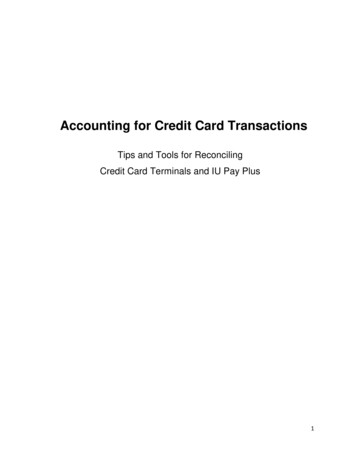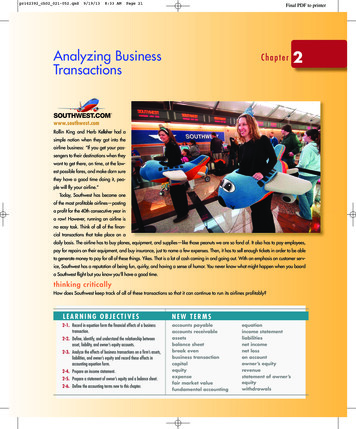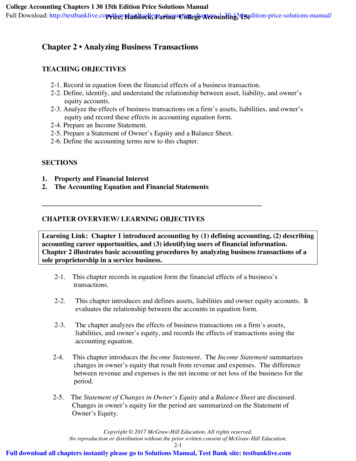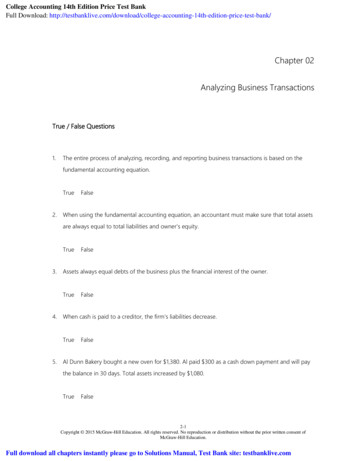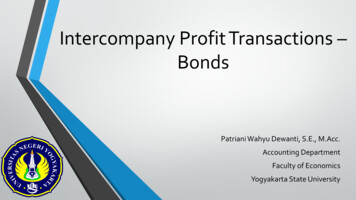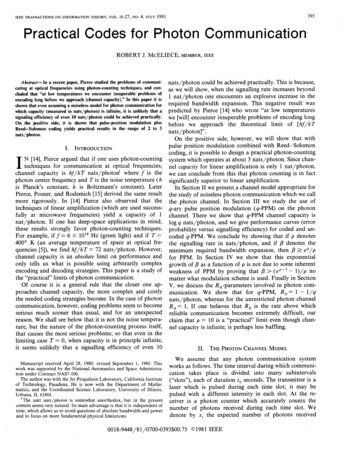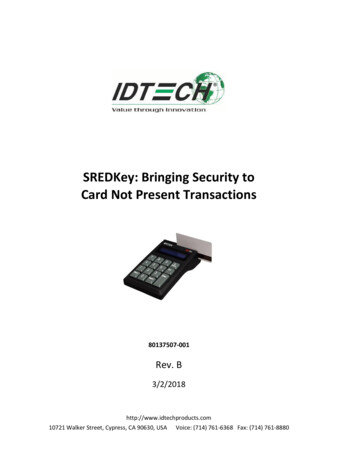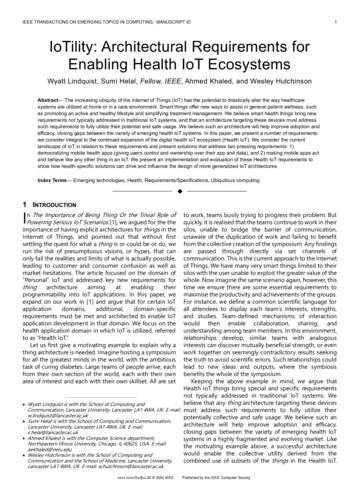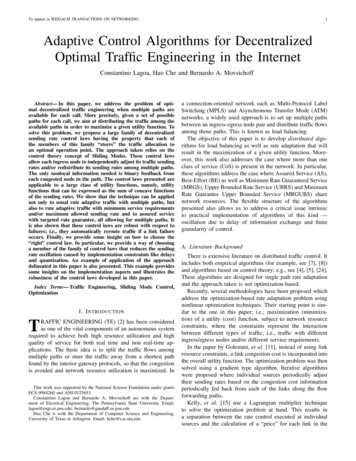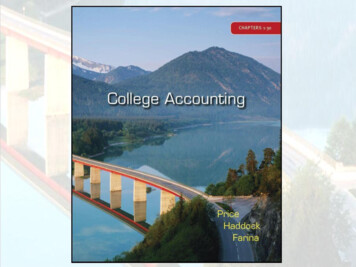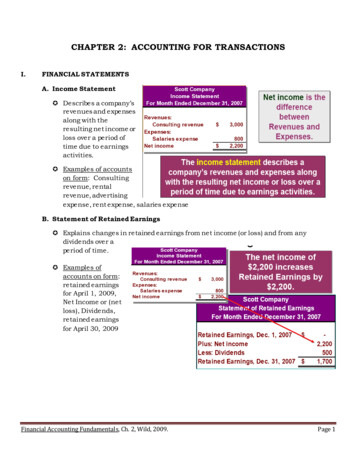
Transcription
CHAPTER 2: ACCOUNTING FOR TRANSACTIONSI.FINANCIAL STATEMENTSA. Income Statement Describes a company’srevenues and expensesalong with theresulting net income orloss over a period oftime due to earningsactivities. Examples of accountson form: Consultingrevenue, rentalrevenue, advertisingexpense, rent expense, salaries expenseB. Statement of Retained Earnings Explains changes in retained earnings from net income (or loss) and from anydividends over aperiod of time. Examples ofaccounts on form:retained earningsfor April 1, 2009,Net Income or (netloss), Dividends,retained earningsfor April 30, 2009Financial Accounting Fundamentals, Ch. 2, Wild, 2009.Page 1
C. Balance Sheet Describes a company’sfinancial position (typesand amounts of assets,liabilities, and equity) at apoint in time. Examples of accounts onform: assets like cash,accounts receivable,supplies, equipment;liabilities like accountspayable; equity likecommon stock andretained earningsD. Statement of Cash Flows Identifies cash inflows(receipts) and cash outflows(payments) over a period oftime. Has three sections: 1st sectionon cash flows from OperatingActivities, 2nd section reportsInvesting Activities, and the3rd section shows cash flowsfrom Financing Activities. Examples of accounts onform: cash from operatingactivities, purchase ofequipment, investments bystockholder, dividends tostockholderFinancial Accounting Fundamentals, Ch. 2, Wild, 2009.Page 2
II. TRANSACTION ANALYSIS AND THE ACCOUNTING EQUATIONA. Accounting Equation1. Assets Resources owned or controlled by a company. Examples: cash, accounts receivable, supplies,equipment, and land These resources are expected to yield future benefits Examples: musical instruments for a rock band, landfor a vegetable grower Receivable—is an asset that promises a future inflowof resources. A company that provides a se rvice or product “on credit’ is said tohave an account receivable from that customer.2. Liabilities What a company owes to its creditors in futurepayments, products, or services. Payable—means a liability that promises afuture outflow of resources. Examples: wages payable to workers, accounts payable to suppliers, notes payable tobanks, taxes payable to the government3. Equity Is the owner’s claim on assets. It is the owner’s actual interest in the business. Also called “net assets” or “residual equity”. Can be found by subtracting total assets from total liabilities.Financial Accounting Fundamentals, Ch. 2, Wild, 2009.Page 3
Corporation’s equity is called stockholders’ equity or shareholders’ equity. Revenues—increase in company resources from the sale of goods or services. Examples: consulting se rvices provided, sales of products, facilities rented toothers, commissions from services Expense—costs encountered in the normal course of business. Examples: costs of employee time, use of supplies, advertising from others, utilitiesfrom others Net Income—an overall measure of performance for the period which equals revenuesless expenses.4. Equationa. Basic Accounting Equation Assets Liabilities Equity Assets must be equal to the claimsagainst those assets. If you have an asset, we can have twobroad categories of claims against that asset. First, we may have claims by creditors, liabilities. Secondly, after all creditor claims are satisfied, owners and stockholders have aclaim on those assets.b.Assets -Financial Accounting Fundamentals, Ch. 2, Wild, 2009.Liabilities- Equity- Page 4
Expanded Accounting EquationCommon stock—when an ownerinvests in a companyin exchange forcommon stock. Dividends—a corporation’s distribution of assets to its owners; it reduces theequity account.B. Transaction Analysis Business activities can be described in termsof transactions and events. Events—are happenings that affect anentity’s accounting equation AND can bereliably measured. Examples: changes in the market value of certain assets and liabilities,natural events such as floods and fires that destroy assets and createlosses During the process of recording business transactions, itis IMPORTANT to always keep the accounting equation inbalance. We can’t let our books get out of balance.III. ANALYZING AND RECORDING PROCESS The accounting process identifies business transactionsand events, analyzes and records their effects, andsummarizes and presents information in reports andfinancial statements. External transactions—where external parties likecreditors, customers, financial institutions and ownershave exchanges of value between the two entities.Financial Accounting Fundamentals, Ch. 2, Wild, 2009.Page 5
Internal transactions—transactions that may involve exchanges between divisions within acompany or payments to employees. The analyzing and recording process consists of:1. Analyze each transaction and event from sourcedocuments2. Record relevant transactions and events in a journal3. Post journal information to ledger accounts4. Prepare and analyze the trial balanceA. Source Documents Identify and describe transactions and eventsentering the accounting process. Provide objective and reliable evidence abouttransactions and events and their amounts. Can be in hard copy form or in electronicform. Examples: sales tickets, checks, purchaseorders, bills from suppliers, employee earnings records, and bank statementsB. The Account and Its Analysis Account—a record of increases and decreases in a specific asset, liability, equity,revenue, or expense item. Account information is analyzed, summarized, and presented in reports and financialstatements. General Ledger (or ledger)—is a record containing all accounts used by a company. Accounts are arranged in three general categories based on the accounting equation: 1.Assets, 2. Liabilities, 3. EquityFinancial Accounting Fundamentals, Ch. 2, Wild, 2009.Page 6
1. Asset Accounts Assets—are resources owned or controlled by a company and that have expectedfuture benefits. Examples: cash, accounts receivable, note receivable (or promissory note), prepaidaccounts, supplies, equipment, buildings, landa. Cash Reflects a company’s cash balance. All increases and decreases in cash are recorded in this account. Examples: money and any medium of exchange that a bank acceptsfor deposit (coins, checks, money orders, and checking accountbalances)b. Accounts Receivable Also called credit sales or sales on account (or on credit). Are promises of payment from customers to sellers. Customers charge the item with the seller, get to take the item home and payfor it later. Account receivables are increased by credit sales. Account receivables are decreased when customers make payments.c. Note Receivable (or Promissory Note) Is a written promise of another person to pay a definite sum of money on aspecified future date to the holder of thenote. A company that is holding a promissorynote signed by another person (entity) hasan asset that is recorded in a Note (orNotes) Receivable account.Financial Accounting Fundamentals, Ch. 2, Wild, 2009.Page 7
d. Prepaid Accounts (also called Prepaid Expenses) Are assets that represent prepayments of FUTURE expenses (NOT currentexpenses). When the expense finally happens through the passage of time or are used up,the amounts in prepaid accounts are transferred to expense accounts. Examples: prepaid insurance, prepaid rent, prepaid services (such as clubmemberships) Prepaid accounts are adjusted when the financial statements are prepared sothat: (1) all expired and used prepaid accounts are recorded as regularexpenses and (2) all unexpired and unused prepaid accounts are recorded asassets. Example: a premium is an insurance fee that is paid in advance for a certainlength of time (i.e. one year). It is listed as Prepaid Insurance and is an assetfor the insurance coverage that we have paid for in advance but haven’t usedyet. Once we use up a month’s worth of insurance, it is deducted from theworth of Prepaid Insurance (an asset) and is recorded as an expense.e. Supplies Are considered assets until they are used. When used up, their costs are reported as expenses. Are grouped by purpose —Office Supplies, Store Supplies Office Supplies includes stationery, paper, toner, pens. Store Supplies includes packaging materials, plastic and paperbags, gift boxes and cartons, cleaning materials.f. Equipment Is an asset. Are grouped by purpose —Office Equipment, Store Equipment Office Equipment includes computers, printers, desks, chairs, andshelves.Financial Accounting Fundamentals, Ch. 2, Wild, 2009.Page 8
Store Equipment includes counters,showcases, ladders, hoists, and cash registersg. Buildings Are assets because they provide expected future benefits to those who controlor own them. Examples: stores, offices, warehouses,and factories Separate accounts are sometimes kept when a business owns several buildings.h. Land The cost of land owned by a business is recorded in a Landaccount. Buildings on that land are recorded in a Building account.2. Liability Accounts Are claims by creditors against assets; obligations to transfer assets orprovide products or services to other entities/companies. Creditors—individuals and organizations that own the right to receivepayments from a company. It’s when your business charges items with another company and still owes themoney. If your business fails to pay the company (creditor) money when it is due, the creditorhas a legal right to take your assets, sell them and pay for your debt. Examples: Accounts Payable, Note Payable, Accrued Liabilitiesa. Accounts Payable Oral or implied promises to pay later, which usually happens from purchases ofmerchandise on account.Financial Accounting Fundamentals, Ch. 2, Wild, 2009.Page 9
It can also happen from purchases of supplies, equipment, and services.b. Notes Payable A formal promise, usually indicated by the signing of a promissory note, to pay afuture amount. Depending on when it is to be paid, it can be recorded either to a short-term NotePayable account or a long-term Note Payable account.c. Unearned Revenue Revenue—also called sales Is when the cash has been received but the product or service has not beendelivered. Example: you subscribe to a magazine, you pay a one -year subscription inadvance. The publishing company has received cash butnothing has been done to earn that revenue. As the magazineis delivered to you, the publishing company recognizes aportion of the money received as revenue. At the end of theyear, all the revenue will be earned and the liability no longerexists.d. Accrued Liabilities Amounts owed that are not yet paid. Examples: Wages Payable, Taxes Payable, Interest Payable3. Equity Accounts Also called stockholders’ equity, or shareholders’ equity Is the owner’s claim on a corporation’s assets. Equity is the owners’ remaining interest in the assets of a business after deductingliabilities.Financial Accounting Fundamentals, Ch. 2, Wild, 2009.Page 10
Equity is affected by four accounts: common stock, dividends, re venues, andexpenses.a. Common Stock When an owner invest in a company in exchange for ashare/stock in the company. Increases equity.b. Dividends Opposite of owner investment anddecreases equity. It’s the distribution of assets to thestockholders. Is an account used in recording assetdistribution to stockholders/owners.c. Revenues When products and services are sold or provided to customers. Increases equity. Examples: Sales, Commissions Earned, Professional Fees Earned, RentEarned, Interest Revenued. Expenses Result from assets and services used in a company’s operation. Decreases equity. Examples: Advertising Expense, Store Supplies Expense, Office SalariesExpense, Office Supplies Expense, Rent Expense, Utilities Expense, InsuranceExpenseFinancial Accounting Fundamentals, Ch. 2, Wild, 2009.Page 11
IV. ANALYZING AND PROCESSING TRANSACTIONSA. Ledger and Chart of Accounts Ledger (or General Ledger)—a record containing all the accounts and theiramounts for a business. A small company may have 20 to 30 accounts. A large company may have several thousand accounts. Chart of Accounts—is a list of allaccounts a company uses andincludes an identification numberassigned to each account. The identification number is a 3-digitcode. The first digit refers to the type ofaccount it is—asset, liability, etc. The second and third digits relate to the accounts’ subcategories.B. Debits and Credits T-account—represents a ledger account; it isused as a tool to understand the effects of one ormore transactions. t-account is in the shape of a capital T. Debit (Dr.)—is the left side of an account. Credit (Cr.)—is the right side of an account. When you enter an amount on the left side of an account, you debit the account. When you enter an amount on the right side of an account, you credit the account. Account balance—is the difference between total debits and total credits for anaccount including any beginning balance.Financial Accounting Fundamentals, Ch. 2, Wild, 2009.Page 12
Debit balance—when the sum of thedebits exceeds the sum of the credits. Credit balance—when the sum of thecredits exceeds the sum of the debits. Zero balance—when the sum of debitsequals the sum of credits.C. Double-Entry Accounting Double-entry accounting—requires that each transaction affects at least twoaccounts and is recorded in two accounts. it also means that the total debits of a transaction must equal the total credits. With transactions, if you increase one side of the accounting equation, you mustincrease the other side. If you decrease one side of the accounting equation, you must decrease the otherside. If the transaction affects only one side of the accounting equation, then oneaccount is increased and one account is decreased. Dividends, Expenses, Assets (DEA) have Normal Balances on the Debit side ORon the side that you increase. Liabilities, Equity, Common Stock, Revenues (LECR) have Normal Balances onthe Credit side OR on the side that you increase. Equity has 4 sub-categories: Common Stock, Dividends, Revenue, Expenses. Common Stock and Revenues INCREASE Equity on the Credit side. Dividends and Expenses DECREASE Equity on the Debit side.D. Journalizing and Posting Transactions Journal—gives a complete record of each transactionin one place.Financial Accounting Fundamentals, Ch. 2, Wild, 2009.Page 13
Journalizing—is the process of recording transactions in a journal. Posting—the process of transferring journal entry information to the ledger. Steps in Processing Transactions:1) Analyze transactions and sourcedocuments.2) Apply double-entry accountingby putting it into T-accounts.3) Record each transaction in ajournal as a journal entry.4) Post journal entry to the ledger.1. Journalizing Transactions General Journal—an all-purpose journalfor recording the debits and credits oftransactions and events. Posting Reference (PR) column—is left blank in a manual system whenentering a transaction in the General Journal. Later this column will be filledin with a number when you post to the Ledgers. The General Journal can be used to record any transaction and includes thefollowing information:1) date of transaction2) titles of affected accounts3) dollar amount of each debit and credit4) explanation of the transactionFinancial Accounting Fundamentals, Ch. 2, Wild, 2009.Page 14
To record entries (transactions) into a General Journal, follow these steps:1) Date the transaction. Enterthe year at the top of thefirst column and the monthand day on the first line ofeach journal entry.2) On the same line as themonth and day, enter titlesof accounts debited alignedwith the left margin of thecolumn. Then enteramounts in the Debitcolumn on the same line.3) On the line below, indent and enter titles of accounts credited. Then enteramounts in the Credit column on the same line.4) Indent half as far as the credited account title on the next line below. It isitalicized. Then enter a brief explanation of the transaction. It references asource document. Then leave a blank line in between transactions forclarity purposes.2. Balance Column Account Is similar to a T-account in that it hascolumns for debits and credits. It also has columns for the Date,Explanation, PR (post reference), and Balance. The heading of the Balance column does not show whether it is a debit or acredit balance.3. Posting Journal Entries To make sure that the ledger is up-to-date, entries are posted as soon aspossible. It could be daily, weekly, or when time permits.Financial Accounting Fundamentals, Ch. 2, Wild, 2009.Page 15
Posting creates a link and a cross-reference between the ledger and the GeneralJournal entry. All entries must be posted to the ledgers before financial statements can beprepared. If it is a debit in the General Journal, then it is a debit in the Ledger. Steps to post a journal entry:1) Identify the ledger account that is debited in the entry; then, in the ledger,enter the entry date, the journal and page in its PR column, the debitamount, and the new balance of the ledger.2) Enter the ledger account number in the PR column of the General Journal.3) and 4) Repeat the first two steps for credit entries and amounts.E. Analyzing Transactions—An IllustrationANALYSISIdentify 1. Determine what accounts are affected.Classify 2. Determine what kind of account it is (i.e. asset, liability, etc.) /-3. Determine if each account increases or decreasesBalance 4. Determine if the accounting equation is in balance.Debit/Credit Rule Which account is debited?Which account is credited?T-AccountsFinancial Accounting Fundamentals, Ch. 2, Wild, 2009.Page 16
1. Investment by OwnerTRANSACTION #1: Shareholders invested 30,000 in FastForward on Dec. 1.ANALYSISIdentify 1. Cash; Common StockClassify 2. Cash Asset; Common Stock Equity /-3. Cash ; Common Stock Balance 4. The equation is balancedDebit/Credit Rule Which account is debited? CashWhich account is credited? Common StockT-AccountsCashCommon Stock -- 30,00030,000Assets CashBal.0AcctsRecv Supp 0Equip-Prepd 0Insur mentLiabAcctsPay EquityCommon–Dividends Reven –Stock00 01 30,000Bal. 30,000 0Expue000 30,000 0 0 0 0 0 30,000 -0 0-0Double Entry:(1)CashCommon StockFinancial Accounting Fundamentals, Ch. 2, Wild, 2009.30,00030,000Page 17
2. Purchase Supplies for CashTRANSACTION #2: FastForward purchases supplies by paying 2,500 cash.ANALYSISIdentify 1 Cash; SuppliesClassify 2. Cash Asset; Supplies Asset /-3. Cash - ; Supplies Balance 4. The equation is balancedDebit/Credit Rule Which account is debited? SuppliesWhich account is credited? CashT-AccountsSupplies Cash- -2,5002,500Assets CashBal. 30,000AcctsRecvSupp 0Equip-Prepd 02 -2,500Bal. 27,500 Insur mentLiab AcctsPay EquityCommon–Dividends Reven –Stock0Expue0 030,00000 0 30,000 -000 2,500 0 2,500 0 0-0Double Entry:(2)SuppliesCashFinancial Accounting Fundamentals, Ch. 2, Wild, 2009.2,5002,500Page 18
3. Purchase Equipment for CashTRANSACTION #3: FastForward purchases equipment by paying 26,000 cash.ANALYSISIdentify 1. Equipment; CashClassify 2. Equipment Asset; Cash Asset /-3. Equipment ; Cash -Balance 4. The equation is balancedDebit/Credit Rule Which account is debited? EquipmentWhich account is credited? CashT-AccountsEquipment Cash- -26,00026,000AssetsCashBal. 27,500AcctsRecv Supp 0Prepd 2,500Insur03 -26,000Bal.1,500Equip- mentLiab AcctsPay EquityCommon–Dividends Reven –Stock0Expue 030,0000 26,000 0 30,000 -000 26,000 0 2,500 0 0-0Double Entry:(3)EquipmentCashFinancial Accounting Fundamentals, Ch. 2, Wild, 2009.26,00026,000Page 19
4. Purchase Supplies on CreditTRANSACTION #4: FastForward purchases 7,100 of supplies on credit.ANALYSISIdentify 1. Supplies; Accounts PayableClassify 2. Supplies Asset; Accounts Payable Liability /-3. Supplies ; Accounts Payable Balance 4. The equation is
Internal transactions—transactions that may involve exchanges between divisions within a company or payments to employees. The analyzing and recording process consists of: 1. Analyze each transaction and event from source documents 2. Record relevant transactions and events in a
